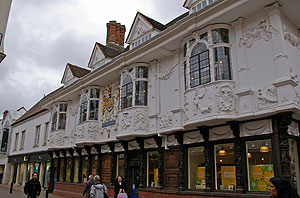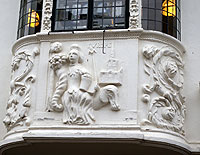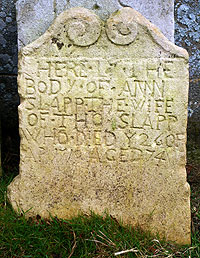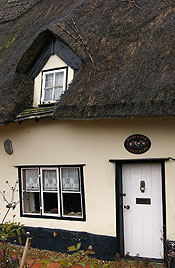Frank's travels around Britain 2009.
Suffolk from Ipswich.
 I
got into the Travel Lodge at Beacon Hill near Ipswich. Very nice staff & I even
ate a
lovely slow cooked ham hock in the Little Chef but, for me, Ipswich is just a
nice town for ladies to shop in.
I
got into the Travel Lodge at Beacon Hill near Ipswich. Very nice staff & I even
ate a
lovely slow cooked ham hock in the Little Chef but, for me, Ipswich is just a
nice town for ladies to shop in.
Yes I know I'm being unfair, But just try finding a website on Ipswich, its full
of "Lifestyle"! There seems very little reference that it is one of
the oldest towns in England with Anglo-Saxon roots & a huge Roman history. There were elements in the town that are fabulous, very much like
Chester but Bath it isn't! You have a multi layered car park in the centre that is reasonably
priced. You are then surrounded by modern shops, a small shopping mall
& dotted here & there are very interesting buildings timber framed
houses.
One place that deserves a special mention and is a credit to preservation & commercialism, The Ancient House, also known as Sparrowes House, is a Grade I listed building dating from the 1400s located in the Buttermarket area. The front of the building, as it can be seen today (in a restored state), was not an original feature of the building - it was later added by Robert Sparrowe between 1660 and 1670. It bears the Royal Coat of Arms of King Charles II, and the words "honi soit qvi mal y pense". This is old French for "shame upon him who thinks evil of it", and is also the motto of the Order of the Garter.
 The Ancient House is now occupied by the Lakeland company. They have done an
outstanding job of showing off this excellent building while allowing real "lady
shopping" to continue. They have even devoted a small area as a museum &
although I'd rather put pins in my eyes than shop, I enjoyed the interior & the
really outstanding way they managed to combine, showing off the building & a shopping
experience, together. Combine this
with the wonderful story of Mary Lakeland & you have a compelling story!
Typically, I only found out about Mary after I returned home (quite standard for
me) but its is worth reading the whole thing from the link below. How about
haunting, witches & King Charles the second to wet your appetite?
The Ancient House is now occupied by the Lakeland company. They have done an
outstanding job of showing off this excellent building while allowing real "lady
shopping" to continue. They have even devoted a small area as a museum &
although I'd rather put pins in my eyes than shop, I enjoyed the interior & the
really outstanding way they managed to combine, showing off the building & a shopping
experience, together. Combine this
with the wonderful story of Mary Lakeland & you have a compelling story!
Typically, I only found out about Mary after I returned home (quite standard for
me) but its is worth reading the whole thing from the link below. How about
haunting, witches & King Charles the second to wet your appetite?
It's fame
today comes from the pargeting
on it's outside. (or
sometimes pargetting,
it is a decorative
plastering applied to building walls). Predominant are the four panels,
showing a
Tudor
impression of the world .
The continents
Africa,
America,
Asia
and
Europe
are shown - notably
lacking
Australasia
which was not discovered
at the time. Africa is represented by a naked man holding a
spear,
Asia by a horse and a
mosque-like building, Europe by a woman with a horse and castle, and America by
a man with a dog at his feet.
 The rest of my trip was going to the top of Suffolk and finding the villages
associated with my family. The Gooderham's were thrown out of Redgrave in
Suffolk in 1818 to Bressingham in Norfolk (about 4 miles!), as they were paupers
& a drain on the poor laws. Now it's a centre for pastel coloured thatched
cottages that cost so much they make your eyes water. No one seems to be there.
No one walks, no shops, just the movement of cars mid week & a village that
looks like its been laid out for tourists like me to photograph. A village
green, a duck pond, pretty signs & pastel coloured thatched cottages. You wander around it's
pretty lanes. Admire the picture book cottages & try to imagine your folk,
so desperately poor, they are asked to leave! Thatched cottages were a cheaper
way to build a home, slates being too expensive. Now its the other way round!
Many are painted in strong pastel colour that appear so uniform, that you
think they are given a list of colours to choose from by the local council. Gone
are the days were they were humble dwellings for the masses.
The rest of my trip was going to the top of Suffolk and finding the villages
associated with my family. The Gooderham's were thrown out of Redgrave in
Suffolk in 1818 to Bressingham in Norfolk (about 4 miles!), as they were paupers
& a drain on the poor laws. Now it's a centre for pastel coloured thatched
cottages that cost so much they make your eyes water. No one seems to be there.
No one walks, no shops, just the movement of cars mid week & a village that
looks like its been laid out for tourists like me to photograph. A village
green, a duck pond, pretty signs & pastel coloured thatched cottages. You wander around it's
pretty lanes. Admire the picture book cottages & try to imagine your folk,
so desperately poor, they are asked to leave! Thatched cottages were a cheaper
way to build a home, slates being too expensive. Now its the other way round!
Many are painted in strong pastel colour that appear so uniform, that you
think they are given a list of colours to choose from by the local council. Gone
are the days were they were humble dwellings for the masses.
 I
thought I'd gone back a long way to 1650 to one of my 7th great grandparents,
when I passed a cottage with 1550 on its wall. It had already stood there 100
years before Henry Bullock was born in the village! This was when Nostradamus
was writing his first Almanac, Edward the VI had come to the throne 3 years
earlier and it was the time of Mary Queen of the Scots. Now the Crossed Keys pub
is run by two nice ladies from Hull. People who worked in London & commuted the
2 hours or more for the pleasure of living in a lovely Suffolk village, have bought
chocolate box homes here.
I
thought I'd gone back a long way to 1650 to one of my 7th great grandparents,
when I passed a cottage with 1550 on its wall. It had already stood there 100
years before Henry Bullock was born in the village! This was when Nostradamus
was writing his first Almanac, Edward the VI had come to the throne 3 years
earlier and it was the time of Mary Queen of the Scots. Now the Crossed Keys pub
is run by two nice ladies from Hull. People who worked in London & commuted the
2 hours or more for the pleasure of living in a lovely Suffolk village, have bought
chocolate box homes here.
 St. Mary's church, that had baptised & married generations of my relatives, was
well outside the village centre, indicating that it was erected to be close to
the Abbots of Bury in Redgrave Hall. A beautiful church with the gravestones
coved in lichen. Of course I didn't find any of my relatives graves, but I wasn't
walking amongst strangers as part of my past was centred in this grave yard.
I did find one old, clear & attractive gravestone of Ann Slapp. She would have
been a contemporary of my kin, Henry Bullock, of Redgrave. A weak link I admit,
but they were real people around Redgrave in 1650. I would love to have a
connection, no matter how tenuous, where the girls of the family were known as
the Slappers!
St. Mary's church, that had baptised & married generations of my relatives, was
well outside the village centre, indicating that it was erected to be close to
the Abbots of Bury in Redgrave Hall. A beautiful church with the gravestones
coved in lichen. Of course I didn't find any of my relatives graves, but I wasn't
walking amongst strangers as part of my past was centred in this grave yard.
I did find one old, clear & attractive gravestone of Ann Slapp. She would have
been a contemporary of my kin, Henry Bullock, of Redgrave. A weak link I admit,
but they were real people around Redgrave in 1650. I would love to have a
connection, no matter how tenuous, where the girls of the family were known as
the Slappers!
Before Redgrave, my earliest Gooderham's were from Eye. It looked like another small village on the map but it turned out to be a proper living centre. Walking people, real shops and cafe with the grumpiest old lady in Suffolk! She was the exception to all I had found down here. Maybe this small, cheerful and all too familiar Northerner got on her wick ... I suspect she didn't pick me out, I think being so miserable was normal. Never mind, she sold good coffee & a lovely walnut cake.
Eye is a living small town. The church is
huge, there is the tiniest castle ruin, on top of the steepest mound I have ever
seen.
 A windmill, built in
1561-2, stood on the motte until the circular mock keep
was built in 1844. The
original Guildhall is a private house & not a museum or a library. Even the
website seems alive & keen to tell
A windmill, built in
1561-2, stood on the motte until the circular mock keep
was built in 1844. The
original Guildhall is a private house & not a museum or a library. Even the
website seems alive & keen to tell
 you about this place. It's hard to imagine
that the name comes from the old English for Island , as there is no hint
that was ever the case. The web site does say it can still be prone to flooding.
Thomas Gooderham was born here in 1658. He was baptised & married in the
church of
St. Peter & St. Paul in Eye. Although I suspect you have to be well off
to live here now, at least the town is alive. I quite liked the whole place. They seem to have
captured the heart of its history & manage to avoid too much of modern life.
you about this place. It's hard to imagine
that the name comes from the old English for Island , as there is no hint
that was ever the case. The web site does say it can still be prone to flooding.
Thomas Gooderham was born here in 1658. He was baptised & married in the
church of
St. Peter & St. Paul in Eye. Although I suspect you have to be well off
to live here now, at least the town is alive. I quite liked the whole place. They seem to have
captured the heart of its history & manage to avoid too much of modern life.
I ended my trip with more southern hospitality. My friend David, who I helped start his family tree, made me very welcome at his home in New Eltham. The conversion was of family trees & computers of course. We swopped information about Genealogy software & who was our favourite search engine but I was truly delighted when I found out he had started a web page about Alfred Robert Morgan his grandfather, another one who laid down his life in the Great War. His wife Lauraine has put in endless hours chasing this man & it's paying off.
Suffolk was wet, dull & cold but full of interest. The lack of sun may have made the place look gloomy but it is a truly picture box county. It always feels strange to walk the lanes your folks lived in, 350 years ago. It may no longer be the same as when they lived but hints & traces of their past do seem to be present all over the place.
Links for
information on this page:
